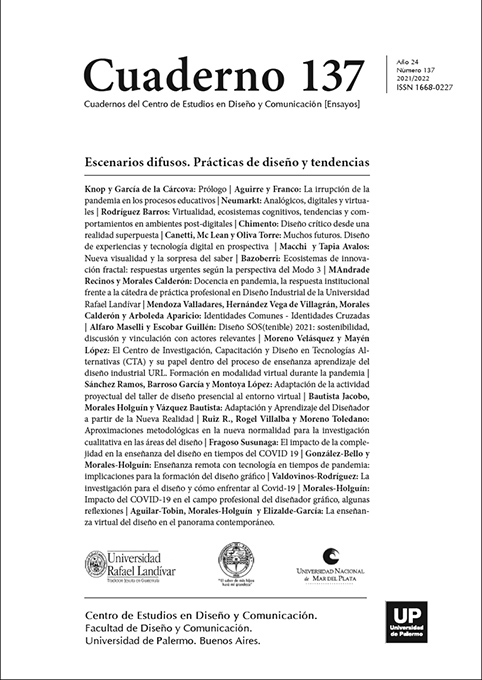La investigación para el diseño y cómo enfrentar al Covid-19
Resumen
Este proyecto explora el campo de la investigación para el diseño como una de las actividades que pueden formar diseñadores gráficos con los conocimientos, habilidades y actitudes para contribuir a entender el nuevo contexto y facilitar las actividades humanas en la adaptación a la nueva realidad, nueva cultura, nuevas maneras de hacer las cosas y nuevas conexiones entre los objetos y sus significados. La investigación debe ser aprendida con estrategias didácticas que acerquen a los estudiantes al usuario y su contexto para que adquieran una visión actualizada y precisa de la evolución de la sociedad.
Citas
Airasian, P. W.; Walsh, M. E. (1997). Constructivist Cautions. En Phi Delta Kappan, Vol. 78.
Bennet, A. G. y Vulpinari, O. (Eds.) (2011). ICOGRADA Manifiesto de educación del diseño gráfico 2011. Italia: ICOGRADA.
Bruner, J. S. (1977). “Early social interaction and language acquisition”. In H. R. Schaffer (ed.) Studies in Mother-infant Interaction (pp. 271–289). London: Academic Press.
Burke, Lisa A. y Miller, Monica K. (1999). Taking the Mystery out of Intuitive Decision Making. En The Academy of Management
Executive (1993-2005), 13(4), 91-99. Consultado en http://www.jstor.org/stable/4165589 Abril 26, 2021.
Crossan, M. M., Lane, H. W. and White, R. E. (1999) An organizational learning framework: From intuition to institution. En Academy of Management Review, Vol 24, No. 3, pp 522-537. (13) (PDF) From Individual Learning to Organizational Learning. Available from: https://www.researchgate.net/publication/252380753_From_Individual_Learning_to_Organizational_Learning [accessed Apr 26 2021].
Dewey, John. (1916). Democracy and education, New York: Macmillan. Eisenhardt, Kathleen M., and Mark J. Zbaracki. “Strategic Decision Making.” En Strategic Management Journal, vol. 13, 1992, pp. 17–37. JSTOR, www.jstor.org/stable/2486364. Accessed 26 Apr. 2021.
Lupton, Ellen. (ed.). (2011a). Graphic design thinking: beyond brainstorming. New York: Princeton Architectural Press.
Lupton, Ellen. (2011b). Foreword. In Armstrong H. & Stojmirovic, Z. Participate designing with user-generated content. New York: Princeton Architectural Press.
Macías, Luis, Valdovinos, Salvador y Rogel, Erika. (2016). Educación para un diseño sostenible y por competencias. En Taller Servicio 24 horas, Año 11 / Num. 22 / Sept 2015-Feb 2016. México: UAM Azcapotzalco. Press, Mike y Rachel Cooper. El diseño como experiencia: El papel del diseño y los diseñadores en el siglo XXI. Barcelona: Gustavo Gili, 2007
Pritchard, Alan y Woollard, John (2010) Psychology for the classroom: constructivism and social learning. En Research Gate Consultado en https://www.researchgate.net/publication/313214018_Psychology_for_the_classroom_constructivism_and_social_learning
Shaughnessy, A. (2010). How to be a graphic designer without losing your soul. New York: Laurence King.
Shea, A. (2012). Designing for Social Change. Strategies for Community-Based Graphic Design. New York: Princeton Architectural Press.
Sinclair, Martha y Ashkanasy, Neal (2005) Intuition: Myth or a Decision-Making tool? En Management Learning. Septiembre 2005 Research Gate.
Stickdorn, Marc y Schneider, Jakob. (2012). This is service design thinking: Basic, tools, cases. New York: Princeton Architectural Press
Valdovinos, Salvador. (2016) “A Comparative Study of Research-for-design: Teaching and Learning in Two Undergraduate Graphic Design Programs in Canada and Mexico”. Tesis de doctorado, Universidad Concordia.
Valdovinos, Salvador y Rogel, Erika. (2021). El Diseño Gráfico en la Industria: Competencias para la nueva realidad, después del Covid-19. En LEGADO de Arquitectura y Diseño. No. 28, Julio-Diciembre 2020.
Vygotsky, Lev S. (1978). Mind in society: The Development of higher psychological processes. M. Cole, V. John-Steiner, S. Scribner, & E. Souberman (Eds.) Cambridge, MA: Harvard University Press.
Los autores/as que publiquen en esta revista ceden los derechos de autor y de publicación a "Cuadernos del Centro de Estudios de Diseño y Comunicación", Aceptando el registro de su trabajo bajo una licencia de atribución de Creative Commons, que permite a terceros utilizar lo publicado siempre que de el crédito pertinente a los autores y a esta revista.


